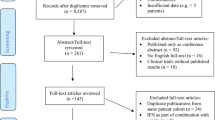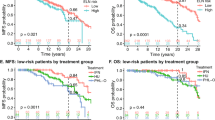Abstract
Nitric oxide (NO), a biologically active mediator generated in many cell types by the enzyme NO synthase, may play an important role in cardiovascular toxicity that is frequently observed in cancer patients during intravenous (i.v.) interleukin 2 (IL-2) therapy. The induction of NO synthase and the production of NO seem to be involved in the pathogenesis of the vascular leakage syndrome, as well as in the regulation of myocardial contractility. In the present study, we evaluated the pattern of plasmatic NO changes during multiple cycles of continuous i.v. infusion (CIVI) of IL-2 in ten advanced cancer patients (five males, five females, median age 59 years, range 33-67 years; eight affected by renal cell cancer and two affected by malignant melanoma). The patients received IL-2 at 18 MIU m-2 day-1 (14 cycles) or 9 MIU m-2 day-1 (seven cycles) for 96 h, repeated every 3 weeks. Interferon alpha (IFN alpha) was also administered subcutaneously (s.c) during the 3 week interval between IL-2 cycles. For each cycle, plasma samples were collected before treatment (t0), 24 h (t1), 48 h (t2), 72 h (t3) and 96 h (t4) after the start of IL-2 infusion, and 24 h after the end of the cycle. NO concentration was determined spectrophotometrically by measuring the accumulation of both nitrite and nitrate (after reduction to nitrite). The following observations may be drawn from data analysis: (1) plasma nitrate + nitrite significantly raised during treatment (P = 0.0226 for t0 vs t3), but statistical significance was retained only when cycles administered with IL-2 18 MIU m-2 day-1 are considered (P = 0.0329 for t0 vs t3; P = 0.0354 for t0 vs t2 vs t4) (dose-dependent pattern); (2) during subsequent cycles a significant trend toward a progressive increase of plasma nitrate + nitrite levels, with increasing cumulative dose of IL-2, was observed (linear regression coefficient r = 0.62, P = 0.0141 for t0; r = 0.80, P = 0.0003 for t1; r = 0.62, P = 0.013 for t2; r = 0.69, P = 0.045 for t3); (3) plasma nitrate + nitrite levels peaked earlier in subsequent cycles than in the first cycle; (4) all patients experienced hypotension. The mean of the systolic blood pressure values was significantly lower at the time of plasma nitrate + nitrite peak than at t0 (P = 0.0004); (5) the two cases of grade III hypotension occurred in patients with the higher mean and peak plasma nitrate + nitrite values. We conclude that determination of plasma nitrate + nitrite levels during CIVI IL-2 can usefully estimate, in a dose-dependent pattern, the degree of peripheral vascular relaxation and capillary leakage associated with cytokine action, clinically manifested as hypotension. However, isolated cardiac toxicity that continues to represent a relevant problem during IL-2 therapy, does not appear to correlate with plasma nitrate + nitrite levels; therefore, further studies are required to understand adequately the mechanisms underlying IL-2-induced cardiac toxicity.
This is a preview of subscription content, access via your institution
Access options
Subscribe to this journal
Receive 24 print issues and online access
$259.00 per year
only $10.79 per issue
Buy this article
- Purchase on Springer Link
- Instant access to full article PDF
Prices may be subject to local taxes which are calculated during checkout
Similar content being viewed by others
Author information
Authors and Affiliations
Rights and permissions
About this article
Cite this article
Citterio, G., Pellegatta, F., Lucca, G. et al. Plasma nitrate plus nitrite changes during continuous intravenous infusion interleukin 2. Br J Cancer 74, 1297–1301 (1996). https://doi.org/10.1038/bjc.1996.533
Issue Date:
DOI: https://doi.org/10.1038/bjc.1996.533



